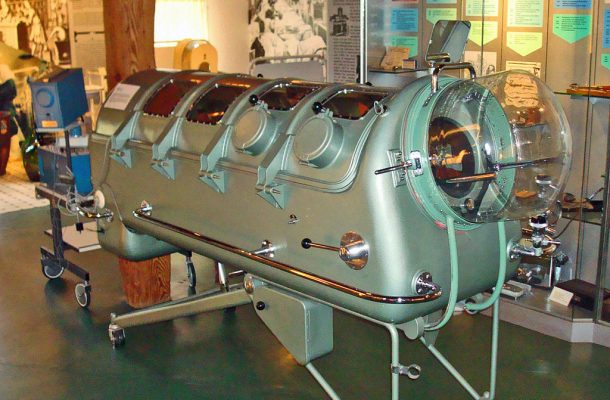The return of the ‘Iron Lung’?

Recent reports question the use of ventilators (positive pressure ventilators) with COVID-19 patients because their use could be leading to complications and or death.
One report indicates that “80% of NYC’s coronavirus patients who are put on ventilators ultimately die, and some doctors are trying to stop using them” because the use of the ventilators may be contributing to the high death rate.
Do complications arise from the use of ventilators in non-Covid-19 patients?
Complications arising from the use of positive pressure ventilators are not limited to Covid-19 patients. SA Health updated its information on Ventilator –associated pneumonia prevention on the 21st of April and that reports that up to one quarter of patients requiring mechanical ventilation develop ventilator associated pneumonia.
Raymondos et al report that tracheal intubation and positive-pressure ventilation as the current standard of care for the adult respiratory distress syndrome (ARDS) seem to have reached their limit in terms of a further relevant reduction of the still very high mortality.
Are there other types of ventilators?
Another type of ventilator is a negative pressure ventilator (NPV), a well-known type of NPV is the “iron lung” made famous through its use with polio patients.

An Emerson iron lung. The patient lies within the chamber, which when sealed provides an effectively oscillating atmospheric pressure. This particular machine was donated to the Centers for Disease Control and Prevention Museum by the family of poliomyelitis patient Barton Hebert of Covington, Louisiana, who had used the device from the late 1950s until his death in 2003.
An ‘iron lung as a type of negative pressure ventilator, a mechanical respirator which encloses most of a person’s body, and varies the air pressure in the enclosed space, to stimulate breathing when muscle control is lost, or the work of breathing exceeds the person’s ability.
The use of iron lungs is largely obsolete in modern medicine, as superior breathing therapies have been developed (positive pressure ventilators), and due to the eradication of polio in most of the world.’
Interestingly there is a local history of the development of the iron lung here in Australia. “Two years before World War II there was a severe outbreak of Poliomyelitis in Adelaide and the Both brothers were asked by the SA Health Department to develop an “Iron Lung”. He soon produced the “Both Cabinet Respirator” in his room behind the Museum.

The “Both Cabinet Respirator”
There had been an earlier American version, but the Adelaide design was much simpler and cheaper to manufacture. During the summer of 1937-38, such was the demand for the “Iron lung”, that within an hour of each one being completed it was being used by a patient. Both’s design soon won world acclaim.
The following year there was a polio epidemic in London and Both moved there to work on new patterns for the respirator. The industrialist Viscount Nuffield announced that he would subsidise, to the extent of £500,000, the supply of “Both” respirators to all parts of Britain and the British Empire. His Morris motor works were soon producing them by the thousand, at one-thirteenth the cost of the American design”.
The track record of “iron lungs”
One remarkable report of the long term use of negative pressure ventilation is that of a polio victim June Middleton of Melbourne, Australia who died on 30 October 2009, who had been entered in the Guinness Book of Records as the person who spent the longest time in an iron lung, died aged 83, having spent more than 60 years in her iron lung.
Given this individual survived for 60 years using an iron lung for up to 21 hours a day, could “iron lung” technologies provide an alternative means of ventilating to Covid-19 patients with fewer complications? Perhaps it could be used until they can no longer be adequately ventilated by this method?
There are reports in the literature about the use of iron lung ventilation to ventilate patients with pulmonary disease.
Corrado investigated the effects of iron lung ventilation compared to invasive mechanical ventilation in patients with acute respiratory failure due to exacerbation of chronic obstructive pulmonary disease. Corrado reports that
· Major complications tended to be more frequent in patients treated with invasive mechanical ventilation than in those treated with iron lung ventilation (27.3% versus 4.5%),
· whereas mortality rate was similar (27.3% versus 18.2%).
· The ventilator-free days and the length of hospital stay were significantly lower in the iron lung ventilation than in the invasive mechanical ventilation group.
This study suggests that iron lung ventilation is as effective as invasive mechanical ventilation in improving gas exchange in chronic obstructive pulmonary disease patients with acute respiratory failure, and is associated with a tendency towards a lower rate of major complications.
More recently a paper co-authored by Corrado reported that negative pressure ventilation with a tank respirator improved gas exchange in patients with acute respiratory distress syndrome at lower trans pulmonary, airway and intraabdominal pressures and, at least initially improving haemodynamics.”
Raymondos et al reported combining negative pressure ventilation with a tank respirator and positive pressure ventilation for the treatment of adult respiratory distress syndrome in a patient that was showing poor and deteriorating oxygenation with the application of intubated positive pressure ventilation alone.
The combination of the two types of ventilators “was able to recruit and maintain lung volume, as indicated by persistently improved oxygenation over five days with PaO2/FiO2 values above 300mmHg, associated with an impressive reduction of alveolar infiltrates.
These effects may be caused by the different way in which ventilator pressures are applied, resulting in a much more effective means of distending the lungs and maintaining lung volumes, as the negative pressure acts across a broad surface of both the chest wall and abdomen”.
Even though “iron lung” ventilators have been described as being largely obsolete, the development of negative pressure ventilators has continued since their use during the “polio epidemics of the 40s and 50s.
A paper by Bach published in 1992 describes fascinating innovations that took the “iron lung” technology from a heavy large tank, where access to the patient is limited and difficult, to portable body ventilators which could be worn up to 24 hours a day and extend patients, suffering from neuromuscular disease, lives for up to a decade.
These innovative “iron lung” ventilators include portable iron lungs, wrap style ventilators, and chest shell ventilators.
Recently, according to Wikipedia, ‘the COVID-19 pandemic revived some interest in the device as a cheap, readily-producible substitute for positive-ventilation ventilators, which were feared to be outnumbered by potential victims temporarily needing artificially assisted respiration.’
These include, a compact, torso-sized “exovent” developed by a team in the United Kingdom, and a full-size iron lung developed in the United States by a team led by Hess Services, Inc. The AIR-AD which is the first, fully-mobile non-invasive ventilator integrated into a piece of clothing and produces pressures equivalent to stationary ventilators while weighing only 3.6kg.

A rendering of the exovent in use – John Hunter/Steer Energy.
Is there support for the use of “iron lungs” to ventilate COVID-19 patients?
One website provides a variety of opinions submitted by readers about using an “iron lung” to ventilate COVID patients. These opinions largely support propagating the status quo e.g. using positive pressure ventilators.
Interestingly the contributors also raise questions about the use of ventilators e.g. ‘The mad rush to ventilate (positive pressure ventilators) acutely ill COVID patients may be viewed as a medical mistake in years to come as more is learned about the course of the disease’.
None of the posts appear to be based on the current knowledge of the types of negative pressure ventilators available nor the benefits they may provide to COVID patients.
There is support for the use of “iron lungs” by organisation both the US and the UK.
Hess is working to get its iron lung approved as an emergency ventilator by the FDA.
The development of the Exovent is supported by family of Stephen Hawking, the late English theoretical physicist, cosmologist, and author, as well as Professor Sir John Burn, chairman of The Newcastle upon Tyne Hospitals Foundation Trust and a former member of NHS England’s board.
Reports about the Exovent include that ‘the Exovent will be delivered to three hospitals in coming days for real-world testing’ (as of the 7th of April) and the recognition that the Exovent offers advantages over current ventilation techniques e.g. “Unlike ventilators, the exovent doesn’t require intubation and is much simpler in design and operation.
In addition, the machine improves heart efficiency by 25 % over conventional ventilators, which can adversely affect cardiac functions. According to the consortium responsible for its design, patients can remain awake, take medications, eat and drink, and talk to their loved ones on the phone.
The developers also say that the exovent can be used in regular wards, which frees up ICU beds for more serious cases. Enclosing only the thorax, the machine does not use compressed air or oxygen, has only a few moving parts, and the components are readily available.
The design is also adaptable for individual patients. The group say the equipment can be built quickly and cheaply with readily available materials and if given the go ahead by government and regulators, to 5,000 machines could be manufactured a week in the UK.”
Conclusion
It appears that both in the US and the UK there is renewed interest by organisations in the potential for negative pressure ventilators to play an important part in the treatment of COVID-19 patients.
These ventilators may not only be cheap and easy to build, they have the potential to improve COVID-19 patient outcomes and if successful may find renewed application in other medical conditions.
Dr Angelo Morella PhD, MRACI CChem, is a Drug Delivery and Pharmaceutical Consultant with over 30 years’ experience in the pharmaceutical industry.















